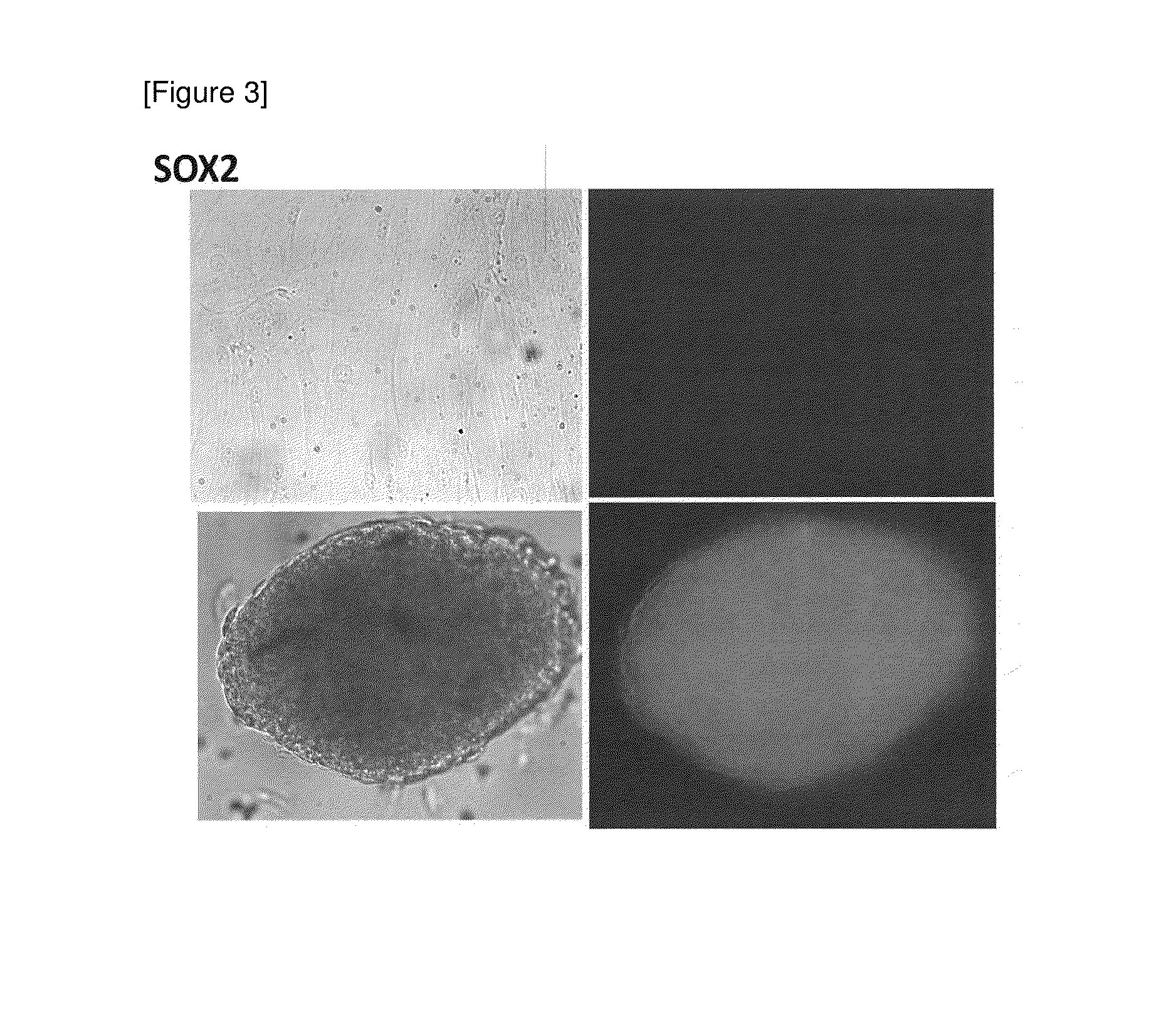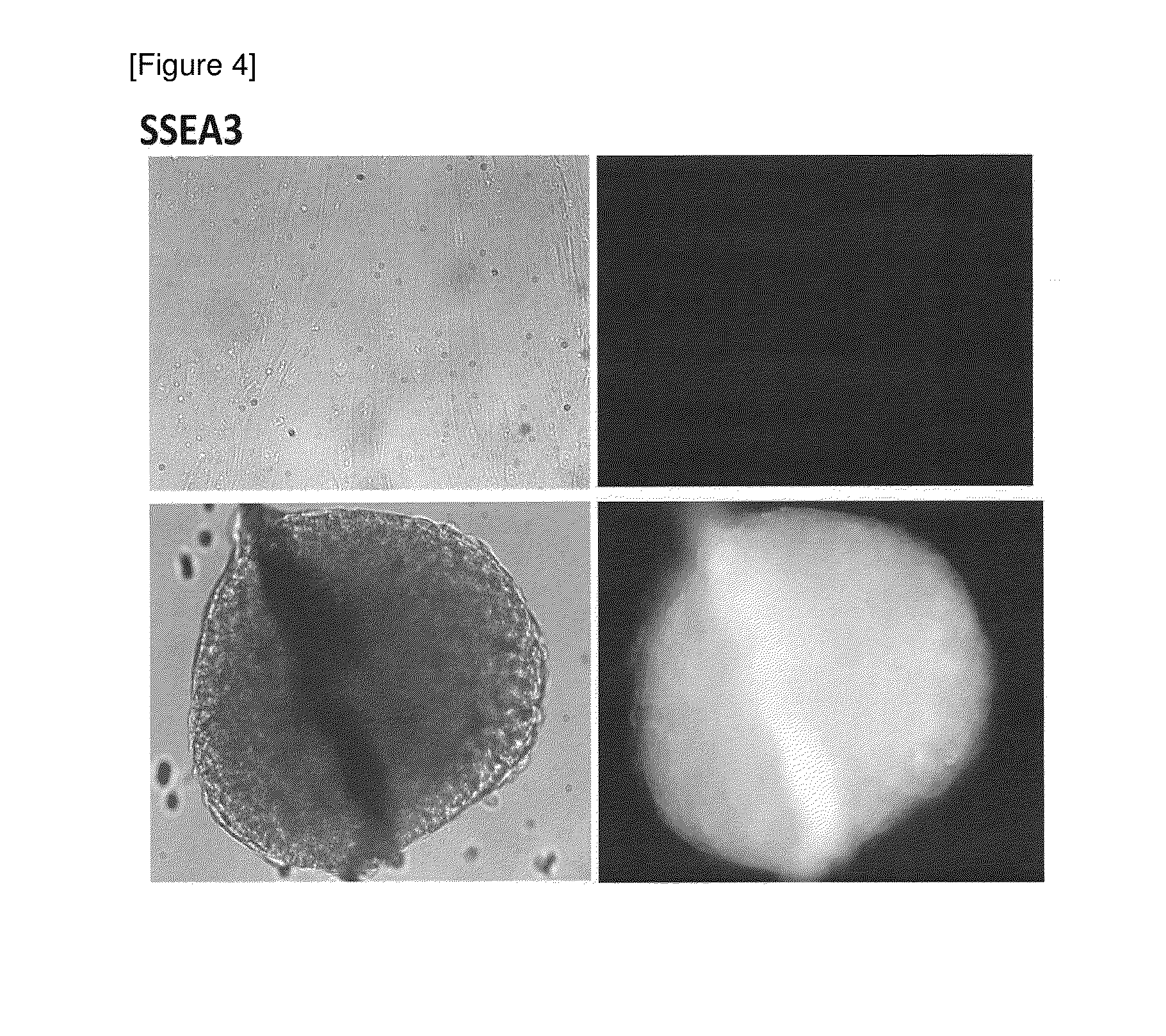Method for preparing pluripotent stem cells
a technology of stem cells and cells, applied in the field of preparation of pluripotent stem cells, can solve the problems of unsatisfactory rejection, risk of tumorigenic transformation as close to zero as possible, and still viewed as a problem, and achieve the effect of convenient preparation at a large scale and low risk of tumorigenic transformation
- Summary
- Abstract
- Description
- Claims
- Application Information
AI Technical Summary
Benefits of technology
Problems solved by technology
Method used
Image
Examples
example 1
1. Confirmation that Cells Expressing Pluripotent Stem Cell Marker are Obtained by Spheroid Culture of hMSC-BM Cells
1-1 Method
1-1-1 Culture of hMSC-BM Cells and Spheroid Culture Method
[0098][1] 16 mL of MSCBM (Mesenchymal Stem Cell Basal Medium) (manufactured by Lonza Group Ltd., PT-3238) supplemented with a set of supplements and factors for mesenchymal stem cells (manufactured by Lonza Group Ltd., PT-4105) (hereinafter, referred to as an “MSCBM culture medium”) was added to a 75 cm2 flask, and the culture medium was warmed and equilibrated in an incubator (37° C., 5% CO2) (30 minutes or longer).
[2] hMSC-BM cells (manufactured by Lonza Group Ltd.) were taken out of liquid nitrogen and quickly thawed in a hot water bath of 37° C.
[3] The thawed cells were transferred to a 15 mL centrifuge tube preliminarily containing 5 mL of an MSCBM culture medium, and mixed.
[4] Centrifugation treatment was carried out at 500 g at 22° C. for 5 minutes.
[5] After removal of the supernatant, 1 mL of a...
example 2
2. Confirmation that Cells Expressing Pluripotent Stem Cell Marker are Obtained by Spheroid Culture of hADSC Cells
2-1 Method
2-1-1 Culture of hADSC Cells and Spheroid Culture Method
[0104][1] 15 mL of ADSC-BM (Adipose Derived Stem Cell Basal Medium) (manufactured by Lonza Group Ltd., PT-3273) supplemented with a set of supplements and factors for human adipose-derived stem cells (manufactured by Lonza Group Ltd., PT-4503) (hereinafter, referred to as an “ADSC-BM culture medium”) was added to a 75 cm2 flask, and the culture medium was warmed and equilibrated in an incubator (37° C., 5% CO2), (20 to 30 minutes or longer).
[2] hADSC cells (manufactured by Lonza Group Ltd.) were taken out of liquid nitrogen and quickly thawed in a hot water bath of 37° C.
[3] The thawed cells were transferred to a 15 mL centrifuge tube preliminarily containing 5 mL of an ADSC-BM culture medium, and mixed.
[4] Centrifugation treatment was carried out at 210 g at 22° C. for 5 minutes.
[5] After removal of the s...
reference example 1
3. Confirmation that Cells Expressing Pluripotent Stem Cell Marker are Obtained by Spheroid Culture of Adherent Mature Cells and Precursor Cells
3-1 Method
3-1-1 Spheroid Culture Method
[0109][hHEP Cells (1 Type of Adherent Mature Cell)]
[1] hHEP cells (manufactured by In Vitro Technologies, Inc.) were taken out of liquid nitrogen and quickly thawed in a hot water bath of 37° C.
[2] The cells were transferred to a 50 mL centrifuge tube.
[3] 25 mL (ice-cold) of a dedicated culture medium for hHEP cells (culture medium for hHEP culture) (see Table 2) was gradually added dropwise to the cells.
[4] The tube was centrifuged at 4° C. (50×g, 3 minutes).
[5] After removal of the supernatant, 5 mL of an ice-cold culture medium for hHEP culture was added to the cells.
[6] The number of cells was counted, and the cells were inoculated to a low adhesive 96-well plate (manufactured by Corning Inc.) (1.0×104 cells / well) and spheroid-cultured for 7 days in an incubator (37° C., 5% CO2) (see “hHEP” in FIG. ...
PUM
 Login to View More
Login to View More Abstract
Description
Claims
Application Information
 Login to View More
Login to View More - R&D
- Intellectual Property
- Life Sciences
- Materials
- Tech Scout
- Unparalleled Data Quality
- Higher Quality Content
- 60% Fewer Hallucinations
Browse by: Latest US Patents, China's latest patents, Technical Efficacy Thesaurus, Application Domain, Technology Topic, Popular Technical Reports.
© 2025 PatSnap. All rights reserved.Legal|Privacy policy|Modern Slavery Act Transparency Statement|Sitemap|About US| Contact US: help@patsnap.com



